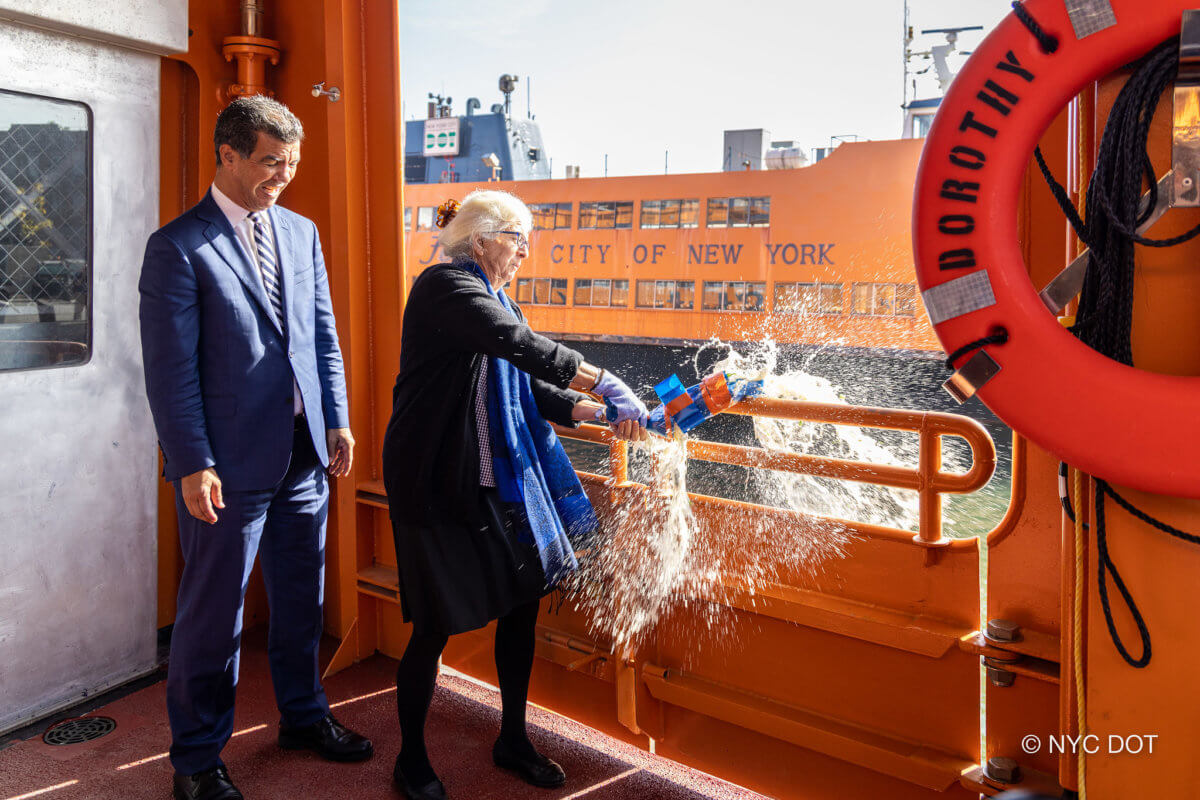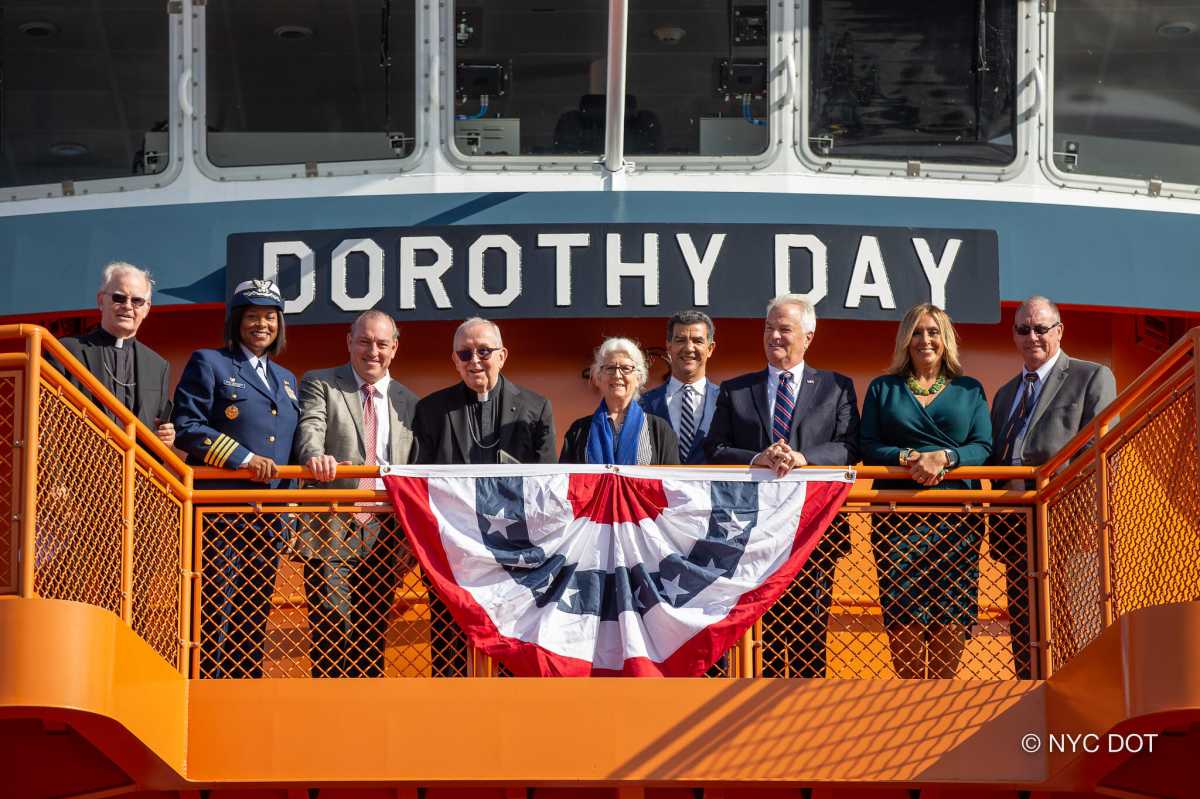All aboard the Dorothy Day!
The city’s Department of Transportation formally commissioned a new Staten Island Ferry boat on Friday, with the orange vessel named in honor of Dorothy Day, the venerable journalist and social justice activist who for decades called Staten Island home.
The Dorothy Day is the third of three new, 4,500-passenger ferries commissioned as part of the Ollis class, the first new vessels running the Manhattan-to-Staten Island route since 2005. The $85 million, 320-foot-long boat was commissioned into service Friday by DOT Commissioner Ydanis Rodriguez and Day’s granddaughter Martha Hennessy, who smashed the ceremonial bottle of champagne on the ship’s stern.
The Dorothy Day will enter passenger service in the coming weeks, joining her two sister ships which began transporting commuters earlier this year: the Staff Sgt. Michael Ollis — named for a native Staten Islander and Army sergeant killed in Afghanistan protecting other soldiers in 2013 — entered passenger service in February, while the Sandy Ground — named for one of New York’s oldest free Black communities, located on the island’s south shore — commenced service in June.

Among the novel amenities on the modernized ships are phone-charging outlets, more comfortable seating, and an outdoor walking track for passengers to burn calories, take in the air, and see the sights from one of New York’s best views.
“Dorothy Day represents so much of what is great about New Yorkers and our city, and we are proud to honor her by commissioning this Staten Island Ferry,” Mayor Eric Adams said in a statement. “Having her name on this boat will remind New Yorkers and visitors alike of her fight for peace and against hunger, fights that we are continuing every day. Thank you to all of those carrying on her legacy.”
Day was one of 20th-century America’s most prominent activists for social justice. An anarchist and leftist by disposition, the native Brooklynite spent her youth working as a journalist and a social justice activist; she was arrested for the first time in 1917 while protesting for women’s suffrage, and embarked on a hunger strike in jail.
Day converted to Catholicism at age 30, and her newfound faith only strengthened her commitment to social justice. In 1933, she founded the Catholic Worker, a social justice-oriented newspaper that she edited until her death.
First sold for a penny-per-copy, the publication was the house organ for a movement of the same name, which interpreted Catholic theology as devotion to a life of service to others through aid to the poor and direct action on their behalf.
The movement established “houses of hospitality” providing shelter, food, and clothing to the indigent, as well as farms for communal living and working. Day used the pages of the Worker to advocate on behalf of pacifism in the face of war and union workers on strike, and she could often be found on the picket line.
She was arrested a number of times for her activities, the last time taking place in 1973 at age 75 on the picket line with striking farmworkers.

Since her death from a heart attack in 1980, Day’s legacy has grown, especially in the world of Catholicism. She was invoked by Pope Francis during a speech to Congress in 2015, and is under consideration for sainthood by the church; for the latter, she has been bestowed the posthumous title “Servant of God.”
Day was intractably linked to Staten Island for much of her life, living on a series of communal farms on the South Shore. She watched the Rock transform during her life from the city’s final countryside frontier to the suburban borough of today.
Day would often take the Staten Island Ferry to travel between her home borough and the house of hospitality on the Lower East Side.
“My grandmother loved the Staten Island Ferry, so what an honor to have one named after her,” said Hennessy. “In these days of global instability, let us use this moment to remember her efforts to make peace.”
Day never rode the ferry for free, as the system charged a fare until the 1990s. Rodriguez posited that Day would probably be fond of the administration’s commitment to keep the ferry free.
“Day loved riding this ferry — as she knew how a short ferry ride can serve as a peaceful, even meaningful, escape from the hustle and bustle of the life in our city,” Rodriguez said. “Best of all, given her lifetime commitment to equity, Day would be thrilled at how DOT is committed to keeping admission to this ferry free for all.”
Less to Day’s hypothetical delight would probably be a heated contract dispute between the city and unionized ferry workers, which has been ongoing for over a decade. Workers say low wages for staffing the ferry have made it hard to attract and retain staffing, contributing to service interruptions over the summer.
The Ollis class is replacing the 1980s-era Barberi class of ferries, including the Andrew J. Barberi, the Samuel I. Newhouse, and the John F. Kennedy. The Kennedy was purchased at auction this year by Saturday Night Live comedians and Staten Island natives Pete Davidson and Colin Jost, forking $280,000 to the city in the hopes of turning the old, asbestos-and-vermin-infested vessel into a comedy club.



































